Abstract
Breeding and cultivating low-N-efficient maize varieties to obtain high yields with less N fertilizer is important for addressing food demands and environmental pollution. However, few studies have investigated the physiological characteristics of low-N-efficient maize varieties. Therefore, we performed an experiment over four years to test two maize varieties (low-N-efficient variety: JNK728, and high-N-efficient variety: XY335) and five N application rates (N120: 120 kg·ha−1, N180: 180 kg·ha−1, N240: 240 kg·ha−1, N300: 300 kg·ha−1, and N360: 360 kg·ha−1). The optimal N application rates for JNK728 and XY335 were N180 and N300, which obtained the highest yields (11,754 and 12,752 kg·ha−1, respectively), N uptake efficiencies (1.32 and 0.93 kg·kg−1), and N harvest index (67.94% and 61.98%), compared with other N application rates. The key period for plant N accumulation was the R1–R6 stage, which contributed 35.2–49.7% and 40.8–53.8% to plant N accumulation at the maturation stage in JNK728 and XY335, respectively. In addition, N accumulation in the grain accounted for more than half (51.8–63.2%) of the total N accumulation in plants, and the leaf N transport amount after the post-silking stage was the primary source of grain N accumulation in both JNK728 and XY335. We also explored the key enzymes and genes related to the N transport amount and efficiency in leaves in the two maize varieties, and found that GOGAT was the key enzyme and GOGAT2 was the key gene for JNK728, whereas the AS enzyme and AS1 and AS3 genes were most important for XY335. Therefore, we suggest that molecular breeding programs should focus on the GOGAT2 gene in low-N-efficient maize varieties, and cultivation techniques should aim to improve the GOGAT enzyme activity after the post-silking period to achieve high yields and N utilization efficiencies with less N fertilizer.
1. Introduction
Maize (Zea mays L.) is among the three major cereal crops grown throughout the world. Improving maize yields is important for addressing the increasing demands for food and livestock feed due to population growth [1]. However, considering the limited potential for expanding the arable land area, the only way to ensure food security appears to be continually enhancing the grain yield per unit area of maize [2]. In recent decades, increases in the maize grain yield in China have mainly been achieved through the application of chemical fertilizer, especially nitrogen (N) fertilizer [3], but increasing the amount of N fertilizer applied can only increase the grain yield up to a certain limit [4]. However, the problem of excessive nitrogen application is growing due to the need to obtain higher grain yields [5,6]. In China, the N application rate increased by 271% between 1997 and 2005, but the grain yield only increased by 71% [7]. Excessive N fertilizer application reduces the N use efficiency, as well as causing various environmental problems, such as water eutrophication, soil acidification, and air pollution [8]. Therefore, it is important to consider both the grain yield and N use efficiency to achieve sustainable agricultural production.
Breeding and selecting high-yielding maize varieties with high N use efficiency (N-efficient maize varieties) may be effective for solving the problems described above [9]. In China, a high grain yield is the goal of traditional breeding, but the N use efficiency is ignored [10]. Indeed, the N use efficiency in China was only 0.25 in 2010 compared with 0.68 in the USA [11]. More recently, the breeding of N-efficient maize varieties has received increasing attention. Previous studies have shown that compared with N-inefficient varieties, N-efficient maize can reduce the N application rate by 16–21% and increase the grain yield by 8–10% [12] due to differences in the accumulation of dry matter after the silking stage [13]. Thus, N-efficient varieties have different agronomic and physiological characteristics compared with the old N-inefficient varieties, such as higher N accumulation [14], dry matter accumulation [15], and photosynthetic rate [16], and a faster grain filling rate [17]. Recently, Chen et al. [10] proposed an ideotype plant architecture for N-efficient maize varieties, including a compact plant architecture, medium plant height, low ear height, short vegetative growth period, long grain filling phase and fast grain filling rate, high grain dehydration rate after physiological maturity, medium crown root number, deep roots, and large root diameter. These previous studies provided effective guidance for the breeding of N-efficient maize varieties.
In plant breeding programs, N-efficient maize varieties are categorized as high-N-efficient varieties and low-N-efficient varieties based on their grain yield performance under different N fertilizer application amounts [18]. Compared with high-N-efficient varieties, low-N-efficient varieties can obtain high yields under low-N fertilizer application amounts, which may be more appropriate for meeting the needs of sustainable agriculture. In terms of the grain yield components, a higher number of grains per ear is required for a higher grain yield from a low-N-efficient variety [19]. Moreover, improving post-silking N accumulation contributes to high yields in low-N-efficient maize varieties [9]. Fan et al. [20] found that low-N-efficient varieties maintain high activities of enzymes comprising ribulose-1,5-bisphosphate carboxylase/oxygenase, phosphoenolpyruvate carboxylase, NADP-malase, and malate dehydrogenase under low-N conditions, thereby increasing the photosynthetic rate and achieving high grain yields compared with high-N-efficient maize varieties. Many previous studies have investigated the agronomic traits and photosynthetic physiology of low-N-efficient varieties, but few have considered the physiological mechanisms related to nitrogen metabolism. In plants, glutamine synthetase (GS) and glutamate synthase (GOGAT) convert inorganic N into organic molecules for other metabolic activities [21]. GS can transform glutamate to glutamine in the leaves, which is related to N accumulation and post-anthesis N uptake [22]. It has been reported that GOGAT participates in glutamate synthesis and is still functional in senescing leaves [23]. Asparagine synthetase (AS) and GS have a joint role in the transport of nitrogen-containing molecules [24]. In addition, nitrate and nitrite accumulation catalyzed by nitrate reductase (NR) and nitrite reductase (NiR) are key factors associated with the regulation of the N use efficiency in maize [25]. The activity of nitrogen metabolism enzymes in plants is regulated by corresponding genes, although the effects of different genes on nitrogen use efficiency vary significantly. Overexpression of genes encoding GS1 in maize has been shown to enhance grain number and yield [26]. In contrast, overexpression of NADH-GOGAT negatively impacts shoot biomass production and has no significant effect on kernel yield [27]. Although overexpression of NR or NiR has frequently enhanced nitrogen uptake, it has typically not led to significant improvements in seed yield, seed protein content, or nitrogen use efficiency [28]. Asparagine synthetase (AS), typically encoded by the AS1, AS2, and AS3 gene family, has been previously identified in maize. Notably, Lee et al. found that AS1 overexpression markedly boosted wheat yield under nitrogen stress conditions [29]. Therefore, understanding nitrogen metabolism mechanisms in low-NUE varieties is crucial for both genetic improvement of maize cultivars and optimization of nitrogen fertilizer application. Our preliminary studies indicated that the superior yield performance of maize variety JNK728 under low-nitrogen conditions was partially attributable to distinct nitrogen metabolism processes [30]. However, the key regulatory organs, critical growth stages, essential enzyme activities, and underlying genetic determinants governing this process in maize remain to be elucidated.
The North China Plain in China and the United States are located in the global maize belt [31], but there are great differences in the yield and N use efficiency between these two areas despite the similarities in their environments and climate [10]. Planting low-N-efficient varieties can undoubtedly help to reduce the differences in the yields and nitrogen use efficiencies. Therefore, in the present study, we performed an experiment over four years by testing two maize varieties (low-N-efficient variety: JNK728, and high-N-efficient variety: XY335) and five N application rates (120 kg·ha−1, 180 kg·ha−1, 240 kg·ha−1, 300 kg·ha−1, and 360 kg·ha−1). The objectives of this study were as follows: (i) to determine the optimal nitrogen application amount for different N-efficient maize varieties; (ii) to assess the key growth periods and organs for N accumulation; and (iii) to analyze the physiological mechanisms associated with N uptake and utilization (key enzymes and genes related to N metabolism) in the low-N-efficient variety.
2. Materials and Methods
2.1. Site Description
A field experiment was performed over four years, from 2018 to 2021 at Changli Experimental Station of Hebei Normal University of Science and Technology (Changli County, Hebei Province, China; 40°4′ N, 118°95′ E), which is located in a typical region of the northeast North China Plain, with a warm temperate and semi-humid continental climate. The annual precipitation and average temperature were 625 mm and 12.5 °C, respectively, during 2008–2021. The monthly precipitation amounts and average temperatures are shown in Figure 1. The frost-free period was approximately 186 days. The soil type was medium loam at the experimental station. The basic soil properties (0–20 cm) were determined at the start of the experiment in 2018 as follows: soil organic matter 21.54 g·kg−1, total nitrogen 1.51 g·kg−1, available phosphorus 10.58 mg·kg−1, and available potassium 85.02 mg·kg−1.
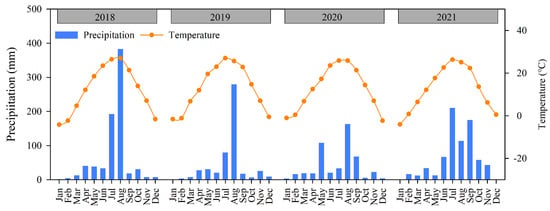
Figure 1.
Monthly precipitation and temperature during 2018–2021.
2.2. Experimental Design and Crop Management
We selected a low-N-efficient maize variety (JNK728) and a high-N-efficient variety (XY335) as the experiment materials; both had been previously screened by our research group [20,31]. Five N levels were tested as basal fertilizers for both varieties: N120: 120 kg·ha−1, N180: 180 kg·ha−1, N240: 240 kg·ha−1, N300: 300 kg·ha−1, and N360: 360 kg·ha−1. Each plot had an area of 36 m2 with three random replicates. Phosphorus at 120 kg P2O5 ha−1 and potassium at 90 kg K2O ha−1 were supplied together with N fertilizer in all plots. Spring maize was planted in mid-May and harvested in late September, and the density of maize was 60,000 plants ha−1 with the row spaces of 0.2 m and 0.6 m. Weeds were controlled by spraying chemical herbicides before crop emergence. Other crop management methods were the same as high-yield cultivation management practices.
2.3. Sampling and Measurements
2.3.1. Grain Yield, Plant N Uptake Efficiency (NupE), Utilization Efficiency (NutE), and N Harvest Index (NHI)
Three random quadrats covering 6 m2 (5 m × 2 row) were selected to measure the maize grain yield in each plot. The plant N content in the maturity stage was determined by using the Kjeldahl digestion procedure. The product of the plant N content and straw yield was the plant N accumulation. The N uptake efficiency (NupE), N utilization efficiency (NutE), and N harvest index (NHI) were calculated by using the following formulae:
NupE = Plant N accumulation at maturity stage/N application rate
NutE = Grain yield/Plant N accumulation at maturity stage
NHI = Grain N accumulation/Plant N accumulation at maturity stage
2.3.2. N Accumulation and Transport to Grain
Plant samples were collected at stages R1 and R6. Plants at stage R1 were divided into five parts comprising leaf, stem, tassel, cob, and bract. And plants at stage R6 were divided into six parts comprising grain, leaf, stem, tassel, cob, and bract. The N contents of organs were determined by using the Kjeldahl digestion procedure. The product of the N content of organs and accumulated dry matter was the N accumulated
N transport amount (NTR) of leaf or stem = N accumulation of leaf or stem at stage R1 − N accumulation of leaf or stem at stage R6
N transport efficiency (NTE) of leaf or stem = NTR of leaf or stem/N accumulation of leaf or stem at stage R1
The contribution of NTR to grain = NTR/grain N accumulation amount at stage R6
2.3.3. Metabolizing Enzymes
Maize leaves were collected at stages R1 and R3, frozen in liquid nitrogen, and ground rapidly. The activities of GS, GOGAT, AS, NiR, and NR were determined using enzyme-linked immunosorbent assays. Kits were obtained from Suzhou Comin Biotechnology, Suzhou, China. Briefly, NR and NiR activities were determined by monitoring the rate of NO2− formation and depletion at 340 nm, respectively. GS activity was measured based on the absorbance of glutamyl hydroxamic acid at 540 nm. Meanwhile, GOGAT and AS activities were assessed by tracking the decrease and increase in NADH absorbance at 340 nm, respectively [32,33].
2.3.4. Gene Relative Expression
Genes encoding enzymes associated with N metabolism were obtained from maizeGDB and GenBank (www.maizegdb.org and www.ncbi.nlm.nih.gov/, both accessed on 5 January 2022). According to the gene sequences obtained from the databases, we designed the gene primers by using Primer Premier 5 and compared them with those in the NCBI database to ensure their specificity. The internal reference was GADPH (Table 1). Real-time fluorescence quantitative PCR was performed by using a Taq SYBR quantitative Green qPCR kit (TaKaRa, Jundong, Japan). The reaction system contained 10 μL SYBR, 0.8 μL upstream primer, 0.8 μL downstream primer, 0.4 μL ROX Reference Dye, and 6 μL sterilized water. The reaction system was mixed with 2 μL cDNA template and diluted 10 times. The reaction mixture was pre-denatured at 95 °C for 30 s, denatured at 95 °C, and amplified at 60 °C for 40 cycles of 30 s. Finally, the relative expression level of each target gene was calculated by using the 2−ΔΔct method.

Table 1.
Primer sequence.
2.4. Statistical Analysis
Data analysis and figure generation were conducted with Microsoft Excel 2019, SPSS 23.0, and SigmaPlot 14.0. Analysis of variance was conducted together with the least significant difference method at a significance level of 0.05. Redundancy analysis was conducted with Canoco 5 to examine the key enzymes that affected the leaf N transport amount and efficiency.
3. Results
3.1. Grain Yield, NutE, NupE, and NHI
The maize variety, N application rate, year, and their interactions significantly affected the grain yield (Figure 2). After four years, the optimal N application rates for obtaining the highest grain yields differed in XY335 and JNK728. The highest grain yield was obtained under N300 for XY335 (four-year average yield: 12,452.5 kg·ha−1), but under N180 for JNK728 (four-year average yield: 11,724.2 kg·ha−1). In different years, the grain yield was higher for JNK 728 than XY335 under N180, except in 2018, but the grain yield was 18–24.4% higher during 2018–2021 under N300 for XY335 compared with JNK728.
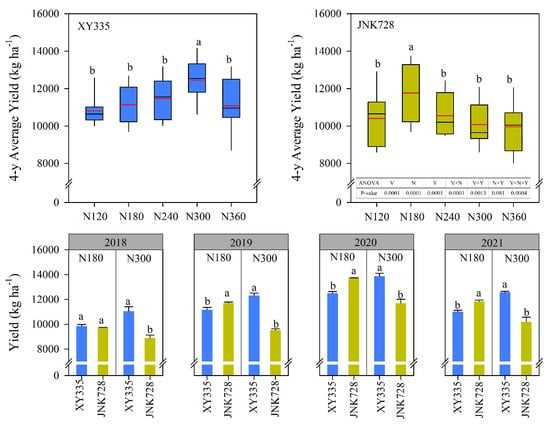
Figure 2.
Grain yield of XY335 and JNK728 under different N application rates. Note: V, variety; N, nitrogen application; Y, year. Different lowercase letters indicate significant differences at 5% (LSD) level between varieties.
We also calculated NupE, NutE, and NHI under different N application rates for XY335 and JNK728 (Table 2). Under N180, compared with XY335, the NupE values were 9.5%, 11%, and 15.5% higher in 2019, 2020, and 2021, respectively, for JNK728. By contrast, under N300, compared with XY335, the NupE values were 25.8%, 21.8%, 14%, and 19.8% lower in 2018, 2019, 2020, and 2021, respectively, for JNK728. The rule of NHI is basically the same as that of NupE. In addition, there were no significant differences in NutE between JNK728 and XY335 under different N application rates. Therefore, NupE and NHI were more important for the N-efficient maize varieties under low-N conditions than NutE.

Table 2.
Nitrogen uptake efficiency (NupE), nitrogen utilization efficiency (NutE) and nitrogen harvest index (NHI) under different N application rates of XY335 and JNK728.
3.2. N Accumulation and Distribution
N accumulation during the growth period varied for XY335 and JNK728 under different N application rates (Figure 3). For XY335, N accumulation increased as the growth stages advanced, with contributions of 7.5–11.1%, 10.8–21.2%, 23.4–35.1%, and 40.8–53.8% in VE–V6, V6–V12, V12–R1, and R1–R6, respectively. The highest N accumulation occurred in R1–R6 under N300. For JNK728, the N accumulation proportions decreased in the following order: R1–R6 > V6–V12 > V12–R1 > VE–V6. N accumulation was higher under N180 compared with the other N application rates. At maturity, the grain made the highest contribution to N accumulation in plants compared with other organs, with 51.8–63% in XY335 and 52.5–63.2% in JNK728 (Figure 4). In addition, N accumulation in the grain was highest in XY335 and JNK728 under N300 and N180 compared with other N application rates.
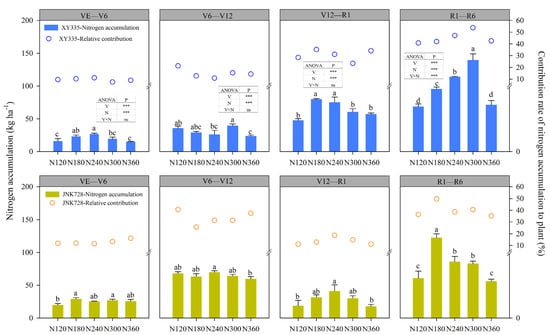
Figure 3.
Nitrogen accumulation during different growth periods and contribution rates of nitrogen accumulation in plants under different N application rates of XY335 and JNK728. Note: Different lowercase letters indicate significant differences at 5% (LSD) level between N application rates. ***, p < 0.001; ns, no significant.
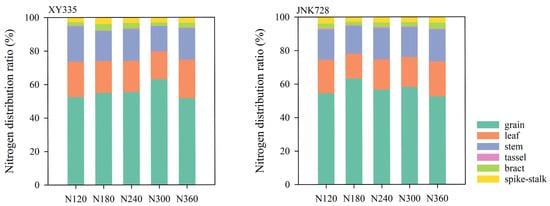
Figure 4.
Relative contribution of organs to accumulated nitrogen at maturity of XY335 and JNK728 under different N application rates.
3.3. N Transport from Leaf and Stem to Grain
N transport from vegetative organs during R1–R6 is an important source of grain N accumulation in the maturity stage. We calculated the N transport amount and efficiency, and the contribution to N accumulation in the grain from the leaves and stems to evaluate the key organ related to the grain N accumulation process (Figure 5). For XY335, the leaf N transport amount and efficiency, and the contribution to grain N accumulation were 25.1–41.3 kg·ha−1, 9.3–16.1%, and 3.7–6.7% higher, respectively, under N300 compared with the other N application rates. The highest N transport amount from the stems also occurred under N300. For JNK728, the N transport amount and efficiency, and the contribution to grain N accumulation were 21–41.9 kg·ha−1, 8.9–16.9%, and 5.8–8.3% higher, respectively, under N180 compared with the other N application rates. Similarly, the highest N transport amount from the stems occurred under N180. However, there were no significant differences in the N transport efficiency from stems and the contribution to grain N accumulation in XY335 and JNK728 under different N application rates. In addition, the N transport amount to the grain from leaves was higher than that from stems in both XY335 and JNK728.
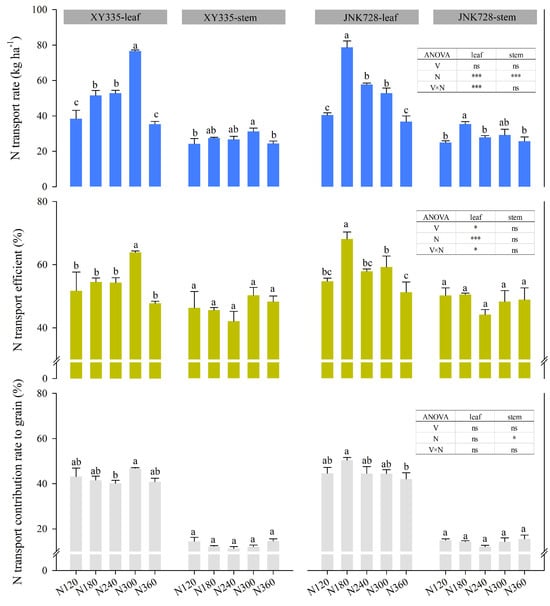
Figure 5.
Nitrogen transport rate, transport efficiency, and contribution rate to grain from leaf and stem under different N application rates of XY335 and JNK728. Note: Different lowercase letters indicate significant differences at 5% (LSD) level between N application rate. *, p < 0.05; ***, p < 0.001; ns, no significant.
3.4. N Metabolism Enzyme Activities of Leaf
The activities of N-metabolizing enzymes in the leaves during stages R1 and R3 are illustrated in Figure 6. In XY335, compared with the other N application rates, the activities of AS and NR in stage R1 were 32.6–57.9% and 32.2–71.6% higher, respectively, under N300, and the activities of GOGAT and AS in stage R3 were 30.4–170% and 14.2–58.4% higher. The activity of GOGAT in stage R1 tended to decrease as the N application rate increased. No differences were found in the activities of other enzymes under different N application rates. In JNK728, compared with the other N application rates, the activities of GOGAT in stages R1 and R3 were 38.7–87.1% and 17.8–33.4% higher, respectively, under N180. The highest activity of NR in stage R3 was observed under N360. Redundancy analysis showed that the activity of AS in stages R3 and R1 was the most important factor that affected the leaf N transport amount and efficiency in XY335 (Figure 7), whereas the most important factor for JNK728 was the activity of GOGAT in stages R1 and R3. The activities of all enzymes in stages R1 and R3 explained 76.91% of the variations in the leaf N transport amount and efficiency under XY335, and 76.68% under JNK728.
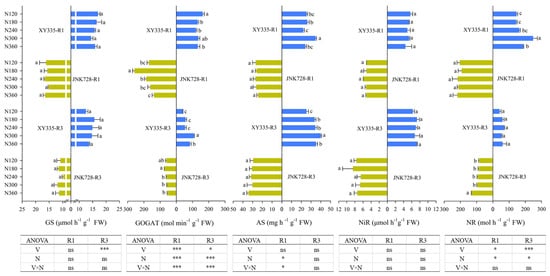
Figure 6.
Glutamine synthetase, glutamate synthase, asparagine synthetase, nitrite reductase, and nitrate reductase activity under different N application rates of XY335 and JNK728. Note: GS, glutamine synthetase; GOGAT, glutamate synthase; AS, asparagine synthetase; NiR, nitrite reductase; NR, nitrate reductase. Different lowercase letters indicate significant differences at 5% (LSD) level between N application rates. *, p < 0.05; ***, p < 0.001; ns, no significant.
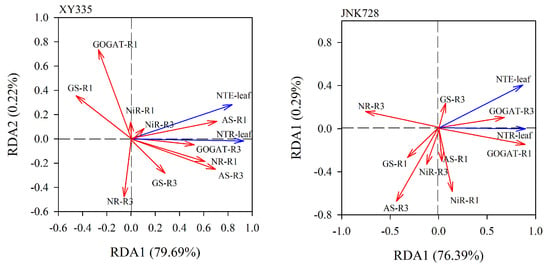
Figure 7.
Redundance analysis between enzyme activity and nitrogen transport rate and transport efficiency. Note: NTE-leaf, nitrogen transport efficient of leaf; NTR-leaf, nitrogen transport rate of leaf; GS, glutamine synthetase; GOGAT, glutamate synthase; AS, asparagine synthetase; NiR, nitrite reductase; NR, nitrate reductase; R1 and R3 represent different growth periods.
3.5. Relative Expression Levels of Key Genes Encoding Enzymes Related to N Metabolism in Leaves
We also determined the relative gene expression levels of AS and GOGAT (Table 3). For XY335, in stage R3, the gene expression levels of AS1, AS2, and AS3 were characterized as decreasing, increasing, and decreasing as the N application rate increased, with peak values under N300. In stage R1, the level of AS1 was highest under N300, but the highest levels of AS2 and AS3 were observed under N180. Correlation analysis showed that AS1 in stages R1 and R3, and AS3 in stage R3 were positively correlated with AS (Figure 8). For JNK728, the highest expression level of GOGAT2 was observed under N180 in stages R1 and R3, and a significant positive relationship was found between the GOGAT2 gene expression level and activity of GOGAT.

Table 3.
Relative expression of key enzyme genes in nitrogen metabolism under different N application rates of XY335 and JNK728.
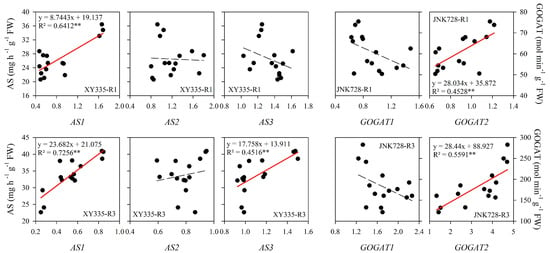
Figure 8.
Correlation analysis of asparagine synthetase, glutamate synthase, and their influencing genes. Note: The red lines indicate a significant correlation. Dashed lines indicate that there is no significant correlation. **, p < 0.01.
4. Discussion
Cultivating N-efficient maize varieties is important for addressing the growing demand for food and preventing environmental pollution due to the excessive application of N fertilizers [34,35]. The grain yield and N use efficiency are key indicators used for assessing N-efficient maize varieties. In the present study, the optimal N application amounts for obtaining the highest grain yields were N300 and N180 in XY335 and JNK728, respectively, which agrees with the classifications of the maize types in our previous experiments: XY335 as a high-N-efficient variety and JNK728 as a low-N-efficient variety (Figure 2). In addition, there was no difference in the grain yield from XY335 under N300 and that from JNK728 under N180. Therefore, the development prospects are greater for low-N-efficient maize varieties such as JNK728 compared with high-N-efficient varieties due to the requirement for less N fertilizer [9,18]. NupE and NutE can quantitatively reflect the capacity for N uptake and the conversion of available N into the grain yield. We found that the changes in NupE and NHI were highly consistent with those in the grain yield (Table 2), but there were no differences in NutE under different N application rates in both varieties, suggesting that NupE and NHI may be more important indicators for achieving high yields and efficiency in N-efficient varieties. Similarly, Haegele et al. [36] and Chen et al. [17] concluded that compared with N-inefficient maize, high N use efficiency in N-efficient maize was mainly due to NupE rather than NutE. Thus, plant breeders should focus on improving NupE and NHI in the future.
To some extent, a higher NupE indicates higher N accumulation in plants during the maturity period. Thus, we analyzed the N accumulation during different growth stages in XY335 and JNK728 under different N application rates (Figure 3). The results showed that 50% of the total N accumulation in plants occurred during stages R1–R6 in both varieties, suggesting that the most critical period for determining N accumulation is after the post-silking period; similar results were obtained by Liu et al. [37]. However, Li et al. [38] found that the grain yield was significantly positively correlated with pre-anthesis N accumulation rather than that during the post-silking stage. Greater N accumulation after the post-silking period improves the stay-green degree of maize and provides more N to the leaves [39], which contributes to the maintenance of a higher level of leaf photosynthesis after post-silking [40] to increase the grain yield [9]. Moreover, we found that the periods when the second highest contributions to N accumulation at maturity occurred were V6–V12 for the low-N-efficient variety (JNK335) and V12–R1 for the high-N-efficient variety (XY335). Therefore, the nutrient supply in V6–V12 is important for the low-N-efficient variety.
Plant N accumulation and the grain N concentration at maturity are significantly correlated with the grain yield [18]. In the present study, N accumulation was highest in the grain compared with other plant organs, with 51.8–63% of the total in XY335 and 52.5–63.2% in JNK728 (Figure 4), which is consist with the result of NHI. In addition, the grain N accumulation amounts in XY335 and JNK728 were highest under N300 and N180, respectively, compared with the other N application rates. These results suggest that the high N accumulation in the grain was the most important component of plant N accumulation, which is consistent with the results obtained by Chen et al. [41] and Ciampitti et al. [42]. The transport of N from vegetative organs after the post-silking stage is the most important source of N accumulation in the grain [9]. Additionally, we analyzed the N transport amounts, transport efficiencies, and contribution rates to the grain from the leaves and stems after post-silking under different N application rates in XY335 and JNK728 in order to identify the key organ that provided the source of N accumulation in the grain (Figure 5). The results showed that the N transport amount, transport efficiency, and contribution rate to the grain from the leaves were higher than those from the stems in both varieties, suggesting that the key organ for N accumulation in the grain was the leaf rather than the stem. Moreover, N accumulation and distribution, leaf N transport amount, and efficiency were higher in JNK728 than XY335 under N180, whereas the opposite was found under N300. However, these preliminary findings necessitate future validation by comprehensive profiling of nitrogen transporter gene expression.
N metabolic pathways are pivotal for N uptake by plants [43], and they are regulated by NR, NiR, GS, GOGAT, and AS. First, NO3− is reduced to NO2− by NR in the cytosol, and then transported into leaf chloroplasts where NO2− is converted into NH4+ [44]. Next, GS, GOGAT, and AS catalyze the conversion of NH4+ into amino acids, which are transferred from source organs to sink organs [45]. Ammonium assimilation enzymes play important roles in its remobilization after post-silking [46]. NH4+ combines with glutamic acid to produce glutamine under catalysis by GS. GOGAT participates in glutamate synthesis and N reutilization [22,47]. The GS/GOGAT cycle is the main pathway for NH4+ assimilation [21]. The main role of AS is catalyzing the formation of asparagine and glutamic acid from glutamine and aspartic acid [24]. The interaction between AS and GS has a crucial role in primary N metabolism [48]. In the present study, we measured the activities of NR, NiR, GS, GOGAT, and AS in the leaves in stages R1 and R3 to explore the key enzymes related to leaf N transport amount and efficiency in low-N-efficient and high-N-efficient maize varieties (Figure 6). We found that the activities of AS and NR in stage R1, and GOGAT and AS in stage R3 were higher under N300 in XY335. By contrast, the activities of GOGAT were higher in stages R1 and R3 under N180 in JNK728. Redundancy analysis showed that the activities of AS in stages R3 and R1 were the most important factors related to the leaf N transport amount and efficiency in XY335 (Figure 7). However, in JNK728, the most important factors were the activities of GOGAT in stages R1 and R3. Previous studies of N-metabolizing enzymes in N-efficient and N-inefficient suggest that enhancing the activity of GS is important for achieving high NutE in N-efficient varieties [23,49]. In our study, we characterized the differences in the activities of N-metabolizing enzymes between low-N-efficient and high-N-efficient maize varieties. We also measured the relative expression levels of genes encoding AS and GOGAT (Table 3). Three genes, AS1, AS2, and AS3, encode AS, and two genes, GOGAT1 and GOGAT2, encode GOGAT [44]. We found that the expression levels of AS1 in stages R1 and R3, and AS3 in R3 stage were positively related to AS, and the expression level of the GOGAT2 gene was positively related to GOGAT.
In the present study, the high relative expression level of the GOGAT2 gene in the low-N-efficient maize variety (JNK728) enhanced the activity of GOGAT after post-silking, thereby increasing leaf N transport to the grain and N uptake by plants to finally obtain a high grain yield under a low-N fertilizer application amount. We suggest that molecular breeding techniques should be applied to focus on GOGAT2 in low-N-efficient maize varieties, as well as implementing appropriate cultivation measures to improve the post-silking agronomic traits of maize to obtain a high yield and NutE with less N fertilizer.
5. Conclusions
The optimal N fertilizer application amounts for JNK728 and XY335 were 180 and 300 kg·ha−1, respectively (four-year average yields: 11,754 and 12,752 kg·ha−1; NutE values: 1.32 and 0.93 kg·kg−1; NHI values: 67.94% and 61.98%). High N accumulation and a high leaf N transport amount to the grain in stages R1–R6 were crucial for N accumulation in plants and the grain at the maturation stage in both the low-N-efficient variety (JNK728) and high-N-efficient variety (XY335) to finally obtain a high grain yield and NutE. The key enzyme and genes for achieving high leaf N transport in XY335 were the AS enzyme and AS1 and AS3 genes, whereas the GOGAT enzyme and GOGAT2 gene were most important in JNK 728. Therefore, we suggest that molecular breeding efforts should focus on the GOGAT2 gene for low-N-efficient maize varieties, as well as appropriate cultivation techniques to improve the GOGAT enzyme activity after the post-silking period to obtain a high yield and NutE with less N fertilizer.
Author Contributions
Conceptualization, H.L. and X.L. (Xiaohu Lin); methodology, H.L. and Y.W.; formal analysis, H.L. and Y.W.; data curation, H.L., Y.W., J.W., M.Z., W.L. and X.L. (Xiangling Li); investigation, Y.W., J.W., M.Z., W.L. and X.L. (Xiangling Li); Writing—original draft, H.L. and Y.W.; writing—review and editing, H.L. and X.L. (Xiaohu Lin). All authors have read and agreed to the published version of the manuscript.
Funding
Funded by Science Research Project of Hebei Education Department (QN2025143).
Data Availability Statement
The data presented in this study are available on request from the corresponding author.
Conflicts of Interest
The authors declare that they have no known competing financial interests or personal relationships that could have appeared to influence the work reported in this paper.
References
- Peng, Q.; Shen, R.; Li, X.; Ye, T.; Dong, J.; Fu, Y.; Yuan, W. A twenty-year dataset of high-resolution maize distribution in China. Sci. Data 2023, 10, 658. [Google Scholar] [CrossRef] [PubMed]
- Luo, N.; Meng, Q.; Feng, P.; Qu, Z.; Yu, Y.; Liu, D.L.; Müller, C.; Wang, P. China can be self-sufficient in maize production by 2030 with optimal crop management. Nat. Commun. 2023, 14, 2637. [Google Scholar] [CrossRef] [PubMed]
- Kong, F.; Wu, Y.; Cui, S.; Wang, X.; Wei, G.; Liu, Q.; Lan, T.; Liu, F.; Zhao, B.; Feng, D.; et al. Effect of chemical fertilizer application on maize production in China over the past 15 years: A meta-analysis. Agronomy 2022, 12, 3005. [Google Scholar] [CrossRef]
- Shi, Z.; Liu, D.; Liu, M.; Hafeez, M.; Wen, P.; Wang, X.; Wang, R.; Zhang, X.; Li, J. Optimized fertilizer recommendation method for nitrate residue control in a wheat–maize double cropping system in dryland farming. Field Crops Res. 2021, 271, 108258. [Google Scholar] [CrossRef]
- Liu, Y.; Pan, X.; Li, J. A 1961–2010 record of fertilizer use, pesticide application and cereal yields: A review. Agron. Sustain. Dev. 2015, 35, 83–93. [Google Scholar] [CrossRef]
- Li, H.; Zhang, Y.; Sun, Y.; Liu, P.; Zhang, Q.; Wang, X.; Wang, R.; Li, J. Long-term effects of optimized fertilization, tillage and crop rotation on soil fertility, crop yield and economic profit on the Loess Plateau. Eur. J. Agron. 2023, 143, 126731. [Google Scholar] [CrossRef]
- Yang, L.; Guo, S.; Chen, Q.; Chen, F.; Yuan, L.; Mi, G. Use of the stable nitrogen isotope to reveal the source-sink regulation of nitrogen uptake and remobilization during grain filling phase in maize. PLoS ONE 2016, 11, e0162201. [Google Scholar] [CrossRef]
- Gu, B.; Chen, B.; Zhang, X. Managing Nitrogen to Achieve Sustainable Development Goals in China. 2023, PREPRINT (Version 1) Available at Research Square. Available online: https://www.researchsquare.com/article/rs-3483975/v1 (accessed on 2 October 2024).
- Bo, Q.; Ma, T.; Wei, X.; Chen, J.; Zhang, Z.; Li, Y.; Tang, A.; Gao, J.; Zhang, J.; Wei, Y.; et al. Improvement of maize post-silking agronomic traits contributes to high grain yield under N-efficient cultivars. Field Crops Res. 2024, 313, 109417. [Google Scholar] [CrossRef]
- Chen, F.; Liu, J.; Liu, Z.; Chen, Z.; Ren, W.; Gong, X.; Wang, L.; Cai, H.; Pan, Q.; Yuan, L.; et al. Breeding for high-yield and nitrogen use efficiency in maize: Lessons from comparison between Chinese and US cultivars. Adv. Agron. 2021, 166, 251–275. [Google Scholar] [CrossRef]
- Zhang, X.; Davidason, E.A.; Mauzerall, D.L.; Searchinger, T.D.; Dumas, P.; Shen, Y. Managing nitrogen for sustainable development. Nature 2015, 528, 51–59. [Google Scholar] [CrossRef]
- Chen, F.; Fang, Z.; Gao, Q.; Ye, Y.; Jia, L.; Yuan, L.; Mi, G.; Zhang, F. Evaluation of the yield and nitrogen use efficiency of the dominant maize hybrids grown in north and Northeast China. Sci. China Life Sci. 2013, 56, 552–560. [Google Scholar] [CrossRef] [PubMed]
- Chai, X.; Ren, Y.; Shi, L.; Dong, X.; Bao, S.; Li, Q. Differences in dry matter production and grain yield of maize (Zea mays L.) cultivars with contrasting nitrogen efficiency. N. Z. J. Crop Hortic. Sci. 2024, 1–23. [Google Scholar] [CrossRef]
- Ciampitti, I.A.; Murrell, S.T.; Camberato, J.J.; Tuinstra, M.; Xia, Y.; Friedemann, P.; Vyn, T.J. Physiological dynamics of maize nitrogen uptake and partitioning in response to plant density and nitrogen stress factors: II. Reprod. Phase Crop Sci. 2013, 53, 2588–2602. [Google Scholar] [CrossRef]
- Zhang, L.; Liang, Z.; He, X.; Meng, Q.; Hu, Y.; Schmidhalter, U.; Zhang, W.; Zou, C.; Chen, X. Improving grain yield and protein concentration of maize (Zea mays L.) simultaneously by appropriate hybrid selection and nitrogen management. Field Crops Res. 2020, 249, 107754. [Google Scholar] [CrossRef]
- Mu, X.; Chen, Q.; Chen, F.; Yuan, L.; Mi, G. Within-leaf nitrogen allocation in adaptation to low nitrogen supply in maize during grain-filling stage. Front. Plant Sci. 2016, 7, 699. [Google Scholar] [CrossRef]
- Chen, X.; Chen, F.; Chen, Y.; Gao, Q.; Yang, X.; Yuan, L.; Zhang, F.; Mi, G. Modern maize hybrids in Northeast China exhibit increased yield potential and resource use efficiency despite adverse climate change. Glob. Change Biol. 2013, 19, 923–936. [Google Scholar] [CrossRef]
- Li, X.L.; Guo, L.G.; Zhou, B.Y.; Tang, X.M.; Chen, C.C.; Zhang, L.; Zhang, S.Y.; Li, C.F.; Xiao, K.; Dong, W.X.; et al. Characterization of low-N responses in maize (Zea mays L.) cultivars with contrasting nitrogen use efficiency in the North China Plain. J. Integr. Agric. 2019, 18, 2141–2152. [Google Scholar] [CrossRef]
- Liu, Z.; Hu, C.; Wang, Y.; Sha, Y.; Hao, Z.; Chen, F.; Yuan, L.; Mi, G. Nitrogen allocation and remobilization contributing to low-nitrogen tolerance in stay-green maize. Field Crops Res. 2021, 263, 108078. [Google Scholar] [CrossRef]
- Fan, Y.; Sun, Y.; Wang, J.; Li, M.; Zhang, M.; Yang, Q.; Han, J.; Wang, X.; Lin, X. Effects of nitrogen fertilizer on photosynthetic characteristics, C4 pathway, and related gene expression of maize varieties with different nitrogen efficiency. Pak. J. Bot. 2024, 56, 1387–1398. [Google Scholar] [CrossRef]
- Masclaux-Daubresse, C.; Daniel-Vedele, F.; Dechorgnat, J.; Fabien, C.; Laure, G.; Akria, S. Nitrogen uptake, assimilation and remobilization in plants: Challenges for sustainable and productive agriculture. Ann. Bot. 2010, 105, 1141–1157. [Google Scholar] [CrossRef]
- Forde, B.G.; Lea, P.J. Glutamate in plants: Metabolism, regulation and signaling. J. Exp. Biol. 2007, 58, 2339–2358. [Google Scholar] [CrossRef] [PubMed]
- Ji, P.; Cui, Y.; Li, X.; Xiao, K.; Tao, P.; Zhang, Y. Responses of photosynthetic characteristics and enzyme activity of nitrogen metabolism to low nitrogen in maize with different nitrogen tolerance. Int. J. Agric. Biol. Eng. 2020, 13, 133–143. [Google Scholar] [CrossRef]
- Gaufichon, L.; Reisdorf-Cren, M.; Rothstein, S.J. Biological functions of asparagine synthetase in plants. Plant Sci. 2010, 179, 141–153. [Google Scholar] [CrossRef]
- Prester, T.; Groh, S.; Landbech, M.; Seitz, G. Nitrogen uptake and utilization efficiency of European maize cultivars developed under conditions of low and high nitrogen input. Plant Breed. 2010, 121, 480–486. [Google Scholar] [CrossRef]
- Fortunato, S.; Nigro, D.; Lasorella, C.; Marcotuli, I.; Gadaleta, A.; de Pinto, M.C. The role of glutamine synthetase (GS) and glutamate synthase (GOGAT) in the Improvement of nitrogen use efficiency in cereals. Biomolecules 2023, 13, 1771. [Google Scholar] [CrossRef]
- Cañas, R.A.; Yesbergenova-Cuny, Z.; Belanger, L.; Rouster, J.; Brulé, L.; Gilard, F.; Quilleré, I.; Sallaud, C.; Hire, B. NADH-GOGAT overexpression does not improve maize (Zea mays L.) performance even when pyramiding with NAD-IDH, GDH and GS. Plants 2020, 9, 130. [Google Scholar] [CrossRef]
- The, S.V.; Rachel, S.; Mechthild, T. Targeting nitrogen metabolism and transport processes to improve plant nitrogen use efficiency. Front. Plant Sci. 2021, 11, 628366. [Google Scholar] [CrossRef]
- Lee, S.; Park, J.; Lee, J.; Shin, D.; Marmagne, A.; Masclaux-Daubresse, C.; An, G.; Nam, H.G. OsASN1 overexpression in rice increases grain protein content and yield under nitrogen-limiting conditions. Plant Cell Physiol. 2020, 61, 1309–1320. [Google Scholar] [CrossRef]
- Wang, J.; Han, J.L.; Yang, M.; Yao, D.D.; Zhou, Y.F.; Wang, W.P.; Wu, Z.X.; Yang, Q. Study on Nitrogen uptake, transport and metabolism of different nitrogen-efficient maize varieties. J. Nucl. Agric. Sci. 2020, 34, 2800–2812. [Google Scholar] [CrossRef]
- Leff, B.; Ramankutty, N.; Foley, J.A. Geographic distribution of major crops across the world. Glob. Biogeochem. Cycles 2004, 18. [Google Scholar] [CrossRef]
- Li, J.; Li, Q.; Guo, N.; Xian, Q.; Lan, B.; Nangia, V.; Mo, F.; Liu, Y. Polyamines mediate the inhibitory effect of drought stress on nitrogen reallocation and utilization to regulate grain number in wheat. J. Exp. Bot. 2024, 75, 1016–1035. [Google Scholar] [CrossRef] [PubMed]
- Rehman, M.; Yang, M.; Fahad, S.; Saleem, M.H.; Liu, L.; Liu, F.; Deng, G. Morphophysiological traits, antioxidant capacity, and N metabolism in ramie under N fertilizer. Agron. J. 2020, 112, 2988–2997. [Google Scholar] [CrossRef]
- Chen, X.P.; Cui, Z.L.; Vitousek, P.M.; Cassman, K.G.; Matson, P.A.; Bai, J.S.; Meng, Q.F.; Hou, P.; Yue, S.C.; Volker, R.; et al. Integrated soil-crop system management for food security. Proc. Natl. Acad. Sci. USA 2011, 108, 6399–6404. [Google Scholar] [CrossRef] [PubMed]
- Hao, T.; Liu, X.; Zhu, Q.; Zeng, M.; Chen, X.; Yang, L.; Shen, J.; Shi, X.; Zhang, F.; deVries, W. Quantifying drivers of soil acidification in three Chinese cropping systems. Soil Tillage Res. 2022, 215, 105230. [Google Scholar] [CrossRef]
- Haegele, J.W.; Cook, K.A.; Nichols, D.M.; Below, F.E. Changes in nitrogen use traits associated with genetic improvement for grain yield of maize hybrids released in different decades. Crop Sci. 2013, 53, 1256–1268. [Google Scholar] [CrossRef]
- Liu, Z.; Sha, Y.; Huang, Y.; Hao, Z.; Guo, W.; Ke, L.; Chen, F.; Yuan, L.; Mi, G. Efficient nitrogen allocation and reallocation into the ear in relation to the superior vascular system in low-nitrogen tolerant maize hybrid. Field Crops Res. 2022, 284, 108580. [Google Scholar] [CrossRef]
- Li, Q.; Ren, Y.; Fu, H.; Li, Z.; Kong, F.; Yuan, J. Cultivar differences in carbon and nitrogen accumulation, balance, and grain yield in maize. Front. Plant Sci. 2022, 13, 992041. [Google Scholar] [CrossRef]
- Bertin, P.; Gallais, A. Genetic variation for nitrogen use efficiency in a set of recombinant maize inbred lines. I. Agrophysiological Results. Maydica 2000, 45, 53–66. [Google Scholar] [CrossRef]
- Lee, E.A.; Tollenaar, M. Physiological basis of successful breeding strategies for maize grain yield. Crop Sci. 2007, 47, S202–S215. [Google Scholar] [CrossRef]
- Chen, K.; Camberato, J.J.; Tuinstra, M.R.; Kumudini, S.V.; Vyn, T.J. Genetic improvement in density and nitrogen stress tolerance traits over 38 years of commercial maize hybrid release. Field Crops Res. 2016, 196, 438–451. [Google Scholar] [CrossRef]
- Ciampitti, I.A.; Vyn, T.J. Physiological perspectives of changes over time in maize yield dependency on nitrogen uptake and associated nitrogen efficiencies: A review. Field Crops Res. 2012, 133, 48–67. [Google Scholar] [CrossRef]
- Meyer, C.; Stitt, M. Nitrate Reduction and signalling. In Plant Nitrogen; Lea, P.J., Morot-Gaudry, J.F., Eds.; Springer: Berlin/Heidelberg, Germany, 2001. [Google Scholar] [CrossRef]
- Anas, M.; Liao, F.; Verma, K.K.; Sarwar, M.A.; Mahmood, A.; Chen, Z.L.; Li, Q.; Zeng, X.P.; Liu, Y.; Li, Y.R. Fate of nitrogen in agriculture and environment: Agronomic, eco-physiological and molecular approaches to improve nitrogen use efficiency. Biol. Res. 2020, 53, 1–20. [Google Scholar] [CrossRef] [PubMed]
- Hirel, B.; Andrieu, B.; Valadier, M.H.; Renard, S.; Quillere, I.; Chelle, M.; Pommel, B.; Fournier, C.; Drouet, J.L. Physiology of maize II: Identification of physiological markers representative of the nitrogen status of maize (Zea mays) leaves during grain filling. Physiol. Plant. 2005, 124, 178–188. [Google Scholar] [CrossRef]
- Oliveira, I.C.; Brears, T.; Knight, T.J.; Clark, A.; Coruzzi, G. Overexpression of cytosolic glutamine synthetase Relation to nitrogen, light, and photorespiration. Plant Physiol. 2002, 129, 1170–1180. [Google Scholar] [CrossRef]
- Kichey, T.; Heumez, E.; Pocholle, P.; Pageau, K.; Vanacker, H.; Dubois, F.; Le Gouis, J.; Hirel, B. Combined agronomic and physiological aspects of nitrogen management in wheat (Triticum aestivum L). Dynamic and integrated views highlighting the central role for the enzyme glutamine synthetase. New Phytol. 2006, 169, 265–278. [Google Scholar] [CrossRef]
- Harrison, J.; Pou de Crescenzo, M.A.; Sene, O.; Hirel, B. Does lowering glutamine synthetase activity in nodules modify nitrogen metabolism and growth of Lotus japonicus? Plant Physiol. 2003, 133, 253–262. [Google Scholar] [CrossRef]
- Singh, P.; Tomar, R.S.; Kumar, K.; Kumar, B.; Rakshit, S.; Singh, I. Morpho-physiological and biochemical characterization of maize genotypes under nitrogen stress conditions. Indian J. Genet. Plant Breed. 2021, 81, 255–265. [Google Scholar]
Disclaimer/Publisher’s Note: The statements, opinions and data contained in all publications are solely those of the individual author(s) and contributor(s) and not of MDPI and/or the editor(s). MDPI and/or the editor(s) disclaim responsibility for any injury to people or property resulting from any ideas, methods, instructions or products referred to in the content. |
© 2025 by the authors. Licensee MDPI, Basel, Switzerland. This article is an open access article distributed under the terms and conditions of the Creative Commons Attribution (CC BY) license (https://creativecommons.org/licenses/by/4.0/).